Casual Collection - July 2011 releases

Was July officially recognized as “Hidden Object Adventure Month” and we just didn’t get the memo? Sweet criminy there were a lot of them! So many, in fact, that you’ll need a Table of Contents just to keep track of them all. And since you’ve got more than enough reading ahead of you already, let’s skip the preamble and get right down to this month’s smorgasboard of casual game offerings.
Page 1: Nightmare Realm, Sacra Terra: Angelic Night
Page 2: F.A.C.E.S., The Missing: A Search and Rescue Mystery
Page 4: Timeless: The Forgotten Town, Unsolved Mystery Club: Ancient Astronauts,
Page 5: Vampire Saga: Welcome to Hell Lock, Millenium Secrets: Roxanne’s Necklace
Page 6: Intrigue Inc: Raven’s Flight, Foreign Dreams, Lara Gates: The Lost Talisman
Nightmare Realm
by Merlina McGovern
What’s your worst nightmare? Losing a loved one? A child? In Nightmare Realm, a lite adventure by Lesta Games and Films, you’ll explore one mother’s nightmare as you enter a dream realm to help get her daughter back from the clutches of mysterious beings who have “extracted” her from reality. Although you may struggle with the nonsensical story, the engaging puzzles, interactive hidden object scenes, and some beautifully trippy graphics make this game a dream to play through.
 The opening cutscene is a harbinger of the otherworldly goodness to come: An artistic still depicts a creepy, non-human finger scratching a long dark nail across a drawing of a car on a cliff. Art alters reality, and the scene ends in a devastating crash. After a harrowing family scene on the cliff’s edge resulting in a man’s death, the game resumes four year’s later as his wife is attempting to pick up the pieces with her daughter Emily and brother-in-law Peter. Emily is about to turn seven, but her birthday party is interrupted by a strange being called an “extractor,” who whisks Emily into one of the drawings decorating her room. You set out with Peter to get your daughter back and plunge into a realm of imagination and nightmares through the drawing, one of Emily’s crayon creations that document a vivid imagination. From this point on, you’ll travel through the realms set up by her other various drawings, attempting to bring life back to withered places, such as diverting water to a surreal desert wasteland or unfreezing a wintry landscape.
The opening cutscene is a harbinger of the otherworldly goodness to come: An artistic still depicts a creepy, non-human finger scratching a long dark nail across a drawing of a car on a cliff. Art alters reality, and the scene ends in a devastating crash. After a harrowing family scene on the cliff’s edge resulting in a man’s death, the game resumes four year’s later as his wife is attempting to pick up the pieces with her daughter Emily and brother-in-law Peter. Emily is about to turn seven, but her birthday party is interrupted by a strange being called an “extractor,” who whisks Emily into one of the drawings decorating her room. You set out with Peter to get your daughter back and plunge into a realm of imagination and nightmares through the drawing, one of Emily’s crayon creations that document a vivid imagination. From this point on, you’ll travel through the realms set up by her other various drawings, attempting to bring life back to withered places, such as diverting water to a surreal desert wasteland or unfreezing a wintry landscape.
The artwork throughout is vivid and at times Dali-esque. A crooked stone path winds its way to a solitary door floating in air. You’ll climb a staircase of mushrooms to find yourself at the edge of an arid canyon dotted with desiccated topiary bushes perched on giant metal springs. These surreal images form the backdrop to a variety of inventory puzzles, logic challenges, and hidden object scenes. The inventory obstacles are not too challenging; clicking on locked doors that need something other than traditional keys usually gives you a hint as to what to look for, and seeking items to complete a potion is aided by a recipe. If you come across a mechanical device that is missing particular pieces, you’ll easily find clues how to fix it, either in your journal or by speaking with the various characters you meet.
The logic puzzles, which range from simple pattern-matching to jigsaws to rotating tile puzzles, are also quite easy, but are offered in abundance and are often beautifully designed. Completing a riddle by arranging tokens depicting all of Emily’s imaginary friends is a treat, as each token is beautifully painted and set in an elaborately carved star. You’ll also want to keep a close eye on the scenery, as frequently you’ll find numbers and other clues to puzzles scrawled into the environment. Hidden object scenes break from the ordinary by including sub-screen layers to search through up close. You’ll also have to move other objects around or combine them together in clever ways to find other objects (highlighted in yellow on the list). It’s a nice change of pace to have such variety in the hidden object scenes themselves.
Both within the hidden object areas and the main environments are clever animations that add depth as well as ramp up the creep factor. Emily’s photograph at home morphs into a creepy doll whose wide eyes ringed with dark lashes blink slowly at you. In an icy hidden object scene, glowing eyes fade in and out of an old tree hollow. The music is pleasant to listen to, with descending piano scales and a thumping, insistent background adding tension where appropriate. Although there is no voice acting, ambient sound is used to great effect as well; urgent knocking on the door in the middle of the night will make you anxious to open up and find out what the emergency is.
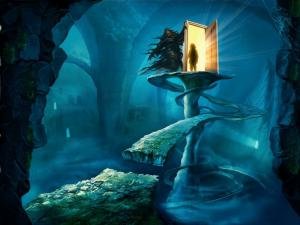 The game definitely has a dreamlike quality, as its descriptions are peppered with poetic lines and quotations from famous writers, such as Rilke’s “the only journey is the one within.” This reminds you of the fact that you’re exploring a fantastical realm rather than the mundane one. However, the storylines and themes don’t quite seem to mesh. You’ll meet witch doctors and mechanical contraptions, tesla machines and factory owners, and honestly, none of it seemed too nightmarish to me. I also found it very difficult to see what these characters had to do with Emily’s seven-year old imagination or exactly why her particular “extractor” needed to abduct her.
The game definitely has a dreamlike quality, as its descriptions are peppered with poetic lines and quotations from famous writers, such as Rilke’s “the only journey is the one within.” This reminds you of the fact that you’re exploring a fantastical realm rather than the mundane one. However, the storylines and themes don’t quite seem to mesh. You’ll meet witch doctors and mechanical contraptions, tesla machines and factory owners, and honestly, none of it seemed too nightmarish to me. I also found it very difficult to see what these characters had to do with Emily’s seven-year old imagination or exactly why her particular “extractor” needed to abduct her.
I much preferred the Collector’s Edition’s bonus play, which follows the trials of Peter, who quickly becomes separated from you in the dream world. In the substantial extra chapter, you’ll explore an entirely different realm, full of surreal desert landscapes with bone cages and claws reaching out from the sand. You’ll meet with a strange woman in a rickety house with its perpetually burning roof. This segment features a fair amount of additional gameplay, tying together its story in a much more succinct way than the main game, while also delving into Peter’s own character motivations and backstory. If you opt for the standard edition, however, you’ll still get about four hours of play time, and despite the fever-dream quality of the main game’s story, Nightmare Realm is anything but a nightmare to play.
Sacra Terra: Angelic Night
by Jack Allin
Normally it’s up to angels to duke it out with demons in the ethereal realm, but when demons make their way to our world, all bets are off. In Alawar’s Sacra Terra: Angelic Night, it’s up to you to destroy the escaped demons representing the seven deadly sins, then find fourteen runes to close the spiritual gate through which they entered. It’d all be in a night’s work if not for the fact that you’re a patient at a decrepit, depraved mental institution, being treated for an illness unknown. Luckily for you, there is an angel on your side, a recently-deceased young girl who knows the town’s wicked past, and will help you right the wrongs committed. She provides items and clues necessary to succeed, but most of the legwork you’ll be doing on your own, as there’s plenty of item scavenging and puzzle-solving to be done before the night is through.
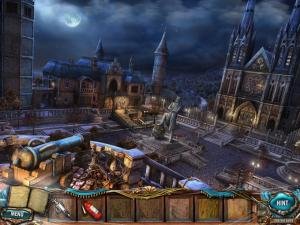 Once free of the hospital, you’ll soon begin to flesh out the backstory that brought the town of Sacra Terra to its defiled state. It’s a rather nasty tale of familial strife, though it ultimately has very little impact on your objectives, which boil down to: find demons, kill demons. Making your way around won’t be easy, however, as demons thrive in darkness, and the town is – not surprisingly – devoid of power and light in many areas. You’ll also encounter inexplicably puzzle-locked doors and other environmental obstacles along the way, not to mention the small matter of finding ways to defeat the devil’s brood.
Once free of the hospital, you’ll soon begin to flesh out the backstory that brought the town of Sacra Terra to its defiled state. It’s a rather nasty tale of familial strife, though it ultimately has very little impact on your objectives, which boil down to: find demons, kill demons. Making your way around won’t be easy, however, as demons thrive in darkness, and the town is – not surprisingly – devoid of power and light in many areas. You’ll also encounter inexplicably puzzle-locked doors and other environmental obstacles along the way, not to mention the small matter of finding ways to defeat the devil’s brood.
Much of this is accomplished through complex inventory machinations, whether it’s creating a succubus to lure the horned lust demon, trapping greed with deadly riches, or concocting a gaseous green potion of “evil wind” (ewww!) to destroy the monstrous demon of gluttony. There are always nearby clues to follow, though as many tasks involve several steps and the game doles out new items rather randomly, it’s often hard to know what to do next at any given time. The map feature, which highlights any areas with current interactions available, is the real godsend here.
Many of these interactions are hidden object searches, which can appear anywhere, anytime. Most scenes are repeated, but objects are not, and some can be difficult to find. That’s partly because only eight objects are displayed at a time, each replaced on the list as you find one, but it’s mainly due the tendency to depict certain items as pale shadows or drawings instead of real objects. Items are rather disappointingly arbitrary as well. Whether rummaging through a cathedral, cemetery, castle towers, or dungeons, I wouldn’t expect to find many pineapples, snowflakes, or Africa outlines. Each search includes one interactive item – some intuitive, some not – and yields one useful item when you’re done. Often these allow access to the logic puzzles, which are fairly standard and entirely contrived, but usually disguised nicely and suitably thematic. You’ll match symbol tokens with corresponding sins, align a ring of Cupid’s arrows, pair animals with geographic locations, and balance scales. Thankfully, the game is light on twiddleware, though you will need to contend with a few tile-swaps and sliders to proceed.

The action takes place all within a fairly limited radius, but there are many scenes to explore in that space, requiring a great deal of backtracking to traverse it all. Fortunately, the hand-drawn artwork is lovely to look at – in that eerie, dark, and ominous sort of way. Despite its demonic premise, this isn’t a horror game per se, but there are some welcome creepy touches, like a syringe sticking from a head-clamped teddy bear, blood-filled IV bags, and appropriately disturbing-looking (yet strangely passive) demons. Even the animation plays a part, as lightning often reveals a shadowy figure (which may give you a start even though it’s you), and there are many dynamic cutscenes sprinkled throughout. There’s no voice acting, unfortunately, and the soundtrack is fairly restrained, wisely opting to allow the ambient sounds of wind and thunder to set the mood for long stretches.
The main game is quite substantial, offering at least four hours of game time with a conclusion that wraps up the town’s crisis nicely, though shedding surprisingly little light on your own character’s predicament. The Collector’s Edition bonus is a prequel chapter that adds another hour of gameplay on top of that. Taking place two days earlier, the story fills in the events that immediately lead up to the main game, yet it offers little in the way of helpful enlightenment, feeling entirely tacked on and out of place. There are more hidden object scenes between new jigsaws, joint-arrangement, and book order puzzles, but unless an hour of gameplay is worth double the cost to you, the standard edition is probably the better investment. Whichever you choose, Sacra Terra: Angelic Night is another solid casual adventure from Alawar. It’s ultimately just another “haunted town” title, but if you’re tired of those, the demonic/angelic theme adds just enough of a twist to answer your prayers for something a little different.
F.A.C.E.S.
By Jason L Blair
Vogat Interactive's supernatural thriller F.A.C.E.S. starts with you, as a young woman, being forced to tap into your extraordinary ability to enter photographs and retrieve objects from within. Soon after, you are locked in your room at the Moonlight Asylum and visited by what appears to be a straitjacket-wearing angel, who tasks you with breaking out of your room and getting free of the hospital. You don't have much time, though, as you are scheduled to be killed the very next day. Before long you are embroiled not only in a tale involving your own abduction and unwilling incarceration, but a wider plot involving a boy who may well possess the ability to fly and a mysterious character known only as Patient X. If that premise, served up in a traditional hidden object adventure, sounds as awesome to you as it does to me, you won’t be disappointed.
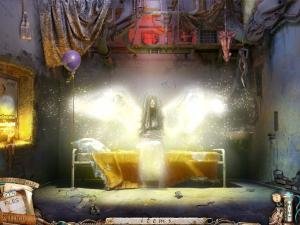 The game takes place almost entirely within the sanitarium, where you must piece together the true history of the place as well as the backstories of the patients and doctors, while your angel visits you periodically to encourage exploration and advance the plot. Despite the ominous circumstances and mostly serious tone, the game does crack a few smiles with moments of self-awareness. The main character sometimes questions the roundabout nature of the puzzles and ponders why she went through such elaborate measures simply to get a key out of an object she could have ripped open with her hands. These sly asides don't come often—the game certainly isn't a comedy—but they're fun when they do.
The game takes place almost entirely within the sanitarium, where you must piece together the true history of the place as well as the backstories of the patients and doctors, while your angel visits you periodically to encourage exploration and advance the plot. Despite the ominous circumstances and mostly serious tone, the game does crack a few smiles with moments of self-awareness. The main character sometimes questions the roundabout nature of the puzzles and ponders why she went through such elaborate measures simply to get a key out of an object she could have ripped open with her hands. These sly asides don't come often—the game certainly isn't a comedy—but they're fun when they do.
About half the gameplay in F.A.C.E.S. comes from hidden object searches. None of these screens require assembly or secondary screens in order to complete the list, though some do require you to find multiples of a single object. Some items are in plain sight but others can be up to 90% obscured by other items on the screens, showing only the corner of an envelope underneath a book, for instance. While most items are context-appropriate, I was sometimes frustrated by the game not accepting my selection of a millipede over a cockroach when the item clue was simply “bug”, or a human skeleton instead of a yellowed, well-hidden femur when the hint read only “bone.” Items are reused often, not just throughout different HOGs but when coming back to the same screen for a second round. I cleared about half of some screens just by clicking on familiar objects before I had read a single entry on the item list.
Puzzles include some familiar standards, such as sliding bi-directional objects around a board and spinning dials on a disc to line up specific sequences. Some are less standard, such as reproducing drawings as the source image changes orientation or untangling a bunch of lines that overlap. There's a good variety, and aside from one particular puzzle needed to light up different areas, none appear more than a couple times. The overall difficulty favors the tougher end, sometimes through well-crafted puzzling but a couple times due to unclear instructions. The thread that ties all the standalone puzzles together is good old inventory work with fairly straightforward item use. If needed, the hint option either highlights an interactive area on the current screen or directs you to your next step with rather explicit text instructions.
The main conceit of the game, the protagonist's ability to enter photographs, is an inventive way of getting more screens out of a limited locale, but this small twist of assembling photos and psychically entering them is an imaginative touch. Many are used to show how you arrived at the asylum in the first place, taking you through such locations as an old store and an underground train station. The theory is that by retracing your steps you will be able to discover how to get out. The story itself unfolds through sequences of animated stills. No one is voiced, even in cutscenes, but the game lets you control transitions between stills, allowing you read at your own pace. The music and sound is excellent, with soft screams and the scraping of metal against metal popping up at particularly tense sequences. These effects serve to really turn the screws at the right moment, and along with a score centered on melodic piano, build a really intense atmosphere.
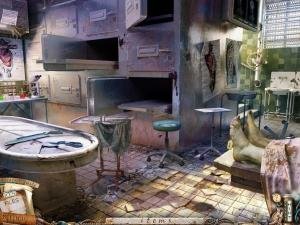
As well done as most of the game is, it falls short in its user interface. The game features a bar along the bottom with a very familiar set-up: the journal sits to the left, the inventory in the middle, and a hint button on the other side. The problem is that the inventory bar is easily activated, and when it pops up it covers a fair bit of real estate. This interfered with navigation at times when I'd try to go back a screen only to bring up my inventory instead, while during hidden object searches the bar overlapped some of the images I was hunting. Given the rather obscured concealment of many items, this made finding them doubly frustrating. There are also moments while exploring when the cursor will bend, implying a new area to visit, but offering nothing to actually click.
Minor flaws aside, F.A.C.E.S. is an engaging and immersive game. Supernatural horror is a popular genre for casual games, and spooky hospitals are second only to haunted houses when it comes to popular horror locales, but this game stands out with a unique mystery and an inventive photograph mechanic that had me racing through the game's four or so hours to the rather brilliant cliffhanger ending. The Collector's Edition includes a bonus chapter that adds about another hour to that, picking up right where the first story ends. The extra chapter employs the same mechanics but is set within your childhood home, providing an emotional backstory to the main game and filling in some holes while leaving just enough so fans will crave a sequel. In either version, F.A.C.E.S. has plenty of high points to more than compensate for its occasional blemish, so if you're a fan of supernatural horror games, get ready to face one of the most compelling casual adventure stories available today.
The Missing: A Search and Rescue Mystery
by Shuva Raha
Buffeted by gale force winds and blinding rain, a seaplane struggles to land on an isolated island, from which meteorology professor Kelvin and four students have gone missing after sending out a distress call. Matters quickly turn as murky as the weather after landing, when the search-and-rescue pilot discovers a heavy-duty cage from which something clearly powerful – and non-human – has escaped. Playing as the pilot in Sulus Games' hidden object adventure The Missing: A Search and Rescue Mystery, it's your job to decode the clues left behind by the missing people in the form of notes, instructions, photos and radio transmissions, in an effort to trace their whereabouts before it is too late.
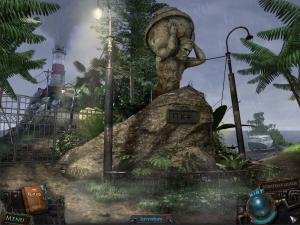 The mission starts well, ominously bringing to life the desolate and menacing, yet undeniably beautiful, islands with a real sense of urgency. Unfortunately, instead of weaving it into a tight, multi-pronged mystery, the developers ingloriously demystify the story by simplistically revealing the villains – both supernatural and human – within the first half hour of the game’s almost four-hour duration, though inexplicably, neither inflict any damage on our protagonist despite multiple opportunities to do so. The secret of Kelvin’s research into harnessing the energy of meteorological phenomena – the cause of the chaos – is exposed all too soon as well. This reduces the challenge to a perfunctory expedition through the tropical isles in vicious weather, collecting tools and solving elementary puzzles to unlock containers, entryways and machines in order to find the science crew and, eventually, defeat the inefficient baddies.
The mission starts well, ominously bringing to life the desolate and menacing, yet undeniably beautiful, islands with a real sense of urgency. Unfortunately, instead of weaving it into a tight, multi-pronged mystery, the developers ingloriously demystify the story by simplistically revealing the villains – both supernatural and human – within the first half hour of the game’s almost four-hour duration, though inexplicably, neither inflict any damage on our protagonist despite multiple opportunities to do so. The secret of Kelvin’s research into harnessing the energy of meteorological phenomena – the cause of the chaos – is exposed all too soon as well. This reduces the challenge to a perfunctory expedition through the tropical isles in vicious weather, collecting tools and solving elementary puzzles to unlock containers, entryways and machines in order to find the science crew and, eventually, defeat the inefficient baddies.
Toto and Fog, the two islands, were once inhabited by an ancient tribe, creating a mélange of aging scientific paraphernalia and indigenous structures adorned with codified hieroglyphs. The newer constructions, which include accommodation camps, a bunker, lighthouse, weather station, an undersea port, a rambling mansion with an antique cannon, and even an incongruous ice station (explained via the ‘control nature’ theory), serve as the setting for the straightforward quests – inventory tasks, hidden object searches, and logic puzzles. As you explore the 100-plus screens, the main focus lies heavily on the search and use of interactive items to solve practical problems. But while these tasks are well-integrated into the story, they are also repetitive and obvious, never taxing your imagination in the slightest. Onscreen hotspots sparkle frequently, further simplifying the process.
There are only fourteen hidden objects screens in the main game, and though they aren’t repeated, they keep regurgitating the same drab items like drills, wrenches, binoculars and hammers. In a slight twist, some of the screens represent dark areas that have to be partially lit using a flashlight, while some have objects displayed as silhouettes instead of words. The dozen-odd standalone puzzles, comprising pattern and number matches, rotator jigsaws, sequencing tasks, gear alignments and pipes variations, are rendered thoroughly undemanding by obvious clues and easy mechanics. Most use codes found elsewhere, and only one – creating a key using a mirror image – poses a genuine challenge due to its visual complexity. Puzzles can be skipped, though it likely won’t be necessary. The rechargeable hint button either marks out onscreen areas where tasks are pending or picks out a random hidden object from the list. You also have to collect 56 energy crystals strewn about the islands to power Kelvin’s invention, but that’s not difficult either.
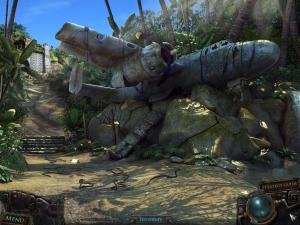 Though linear in logic, the game offers multiple areas for exploration at all times, each requiring repeated visits, though the smart placement of locations and sound rationality of the tasks prevent backtracking from becoming tedious. A journal records broad objectives and discovered clues, and maps out the islands and your current placement. While areas aren’t explicitly marked off as 'completed', at key junctures cleverly designed events cordon off places where no activities are left.
Though linear in logic, the game offers multiple areas for exploration at all times, each requiring repeated visits, though the smart placement of locations and sound rationality of the tasks prevent backtracking from becoming tedious. A journal records broad objectives and discovered clues, and maps out the islands and your current placement. While areas aren’t explicitly marked off as 'completed', at key junctures cleverly designed events cordon off places where no activities are left.
Despite the simplistic gameplay and non-mystery of its plot, The Missing manages to hold your attention due to its sleek, intricate production. Realistic art, graceful ambient animation (lightning, wind tunnels, swinging doors and lights), relevant sound effects, and an intense but soulful soundtrack generate a fair bit of drama, often creating the illusion of actually exploring the drippy, forested islands. The first-person perspective is underlined by bordering the screens with the edges of scuba goggles or a fur-lined jacket hood when worn. Several fully-animated cutscenes intersperse the proceedings, and some, like the sequence of the seaplane crashing into the ocean, are spectacular. There’s no voice acting, but given that most of the adventure is solitary, that’s not a critical omission.
The main game wraps up with an all-too-convenient but conclusive finale, so the Collector’s Edition provides an hour-long unnecessary prologue of how Kelvin discovered the islands in his youth and thought up his project. The six hidden object screens are repeated once each, and yield mundane tools from random collections of Mayan statues, Indian figurines and gothic gargoyles. The half-dozen watered down standalone puzzles require you to manually note some of the code patterns to avoid backtracking. This chapter emphasizes inventory quests built around Kelvin’s escape from an indigenous temple, and the clever interplay of natural elements make the final half-hour almost worth the extra investment.
Despite starting with the strong premise of a search-and-rescue operation gone wrong, set against a visually arresting backdrop bolstered by superior production quality, this game quickly loses its way and ends up in hackneyed territory. It pointlessly overloads the sensible plot with diverse topics such as the pitfalls of human greed, environmental consciousness, and marvelous anthropological legacies, and tries to intimidate with two namby-pamby villains instead of the true obstacle to any rescue effort – the uncontrollable forces of nature (ironically, just what it’s preaching about). The tried-and-true casual gameplay still holds up as moderately entertaining, but ultimately, The Missing: A Search and Rescue Mystery misses its landing on the shores of greatness and skids into the dreaded so-so zone.
Macabre Mysteries: Curse of the Nightingale
by Jack Allin
Note to adventure game protagonists: if you get invited to an old theater that has been closed for decades and is rumoured to be haunted…don’t go! Subsequent note to players: since adventure game protagonists will inevitably ignore all warnings (including blood-red signs on the front gate urgently declaring “Stay Away!”), such invitations are usually good for a solid romp through eerie, surreal environs. This generally holds true for Blue Tea Games’ fragment object adventure Macabre Mysteries: Curse of the Nightingale, which is nearly a carbon copy of the studio’s previous Dark Parables series set in a new locale. It relies a little too much on repetition and its outcome is obvious very early on, but there are plenty of obstacles awaiting in the Nightingale Theater, and not all of them are puzzles.
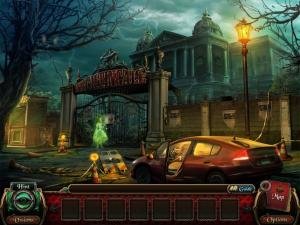 After receiving a 30-year old letter from your missing grandfather asking you to meet him at the site of his final performance, you arrive just in time to see a tormented ballerina ghost outside the gates. Closed since a blazing fire ended in tragedy, the theater soon reveals a tangled web of love, jealousy, betrayal, and remorse among its former cast of characters, including the strongman, a singer, two dancers, and your grandfather, the director. Along with lingering spectres, a savage humanoid beast also roams the building, while a young journalist is snooping around for a story and the town mayor arrives to pay her respects to the dear old landmark a week before its demolishment. Before the night is out, however, each has a crucial role to play in uncovering the theater’s dark secrets, as does your unexplained ability to see into the past at predetermined times. It’s a premise rife with spooky possibilities, though not nearly enough is done with it. Conveniently revealing notes and visions suck most of the mystery from the game an hour in, and for a haunted old building with a tragic history, it’s surprisingly well-kept, brightly lit and perfectly accessible to visitors…
After receiving a 30-year old letter from your missing grandfather asking you to meet him at the site of his final performance, you arrive just in time to see a tormented ballerina ghost outside the gates. Closed since a blazing fire ended in tragedy, the theater soon reveals a tangled web of love, jealousy, betrayal, and remorse among its former cast of characters, including the strongman, a singer, two dancers, and your grandfather, the director. Along with lingering spectres, a savage humanoid beast also roams the building, while a young journalist is snooping around for a story and the town mayor arrives to pay her respects to the dear old landmark a week before its demolishment. Before the night is out, however, each has a crucial role to play in uncovering the theater’s dark secrets, as does your unexplained ability to see into the past at predetermined times. It’s a premise rife with spooky possibilities, though not nearly enough is done with it. Conveniently revealing notes and visions suck most of the mystery from the game an hour in, and for a haunted old building with a tragic history, it’s surprisingly well-kept, brightly lit and perfectly accessible to visitors…
Except, of course, for all the bizarre puzzles impeding your progress. You’ll need various tickets to enter the music, magic, and other theatrical stage shows, and finding those often involves completing puzzles that themselves require collecting sets of Oriental masks, clown dolls, dancing figurines, and crystal balls. Once gathered, arranging them in sequence is an extremely simple task, but finding them in the first place is much more challenging. Some of them, plus other keys, tools, and functional inventory objects, are acquired through the many fragment object searches. Instead of collecting whole items, you’ll usually (with a few rare exceptions) be hunting for bits and pieces of objects that combine to form a whole at the end. Fragment images are displayed on screen, which sounds easy, but the scenes are relatively packed and it’s harder to find nondescript pieces than full items. It’s even harder when some fragments are partially obscured, which left me grumbling a few times, though a rechargeable hint is always there in a pinch. Though you’ll never collect the same items twice, each screen is revisited to pad out play time, and new searches are activated without much notice. The journal does highlight to alert you that its mini-map has been updated with active areas of interest, but it also does that whenever a new character profile or objective change occurs, making it more a nuisance than help.
 Hints aren’t very useful during exploration either. Instead of using the standard method of pinpointing interactive areas or even offering text clues of what to try next, here the only help you’ll get is to see where an inventory item can be used. Given the number of objects you collect and the non-linear nature of the game, this can be counterproductive, because you may see clues you really don’t want, including hints to some objects you can’t even use yet. And that’s if you can use them at all. Opting to skip a standalone puzzle locks the feature for five minutes, though once you get the hang of the puzzles, you’ll likely cruise through the rest. That’s because there are only a few different types available. You’ll encounter the odd simple jigsaw or Lights Out sequence, but most of the time you’ll be solving one of two kinds: a themed icon-swapping task to complete a chronological sequence or a slider puzzle to match related objects in rows. Both are quite clever the first couple times around; they’re far less so the fifth time and beyond. A little more variety would have gone a long way.
Hints aren’t very useful during exploration either. Instead of using the standard method of pinpointing interactive areas or even offering text clues of what to try next, here the only help you’ll get is to see where an inventory item can be used. Given the number of objects you collect and the non-linear nature of the game, this can be counterproductive, because you may see clues you really don’t want, including hints to some objects you can’t even use yet. And that’s if you can use them at all. Opting to skip a standalone puzzle locks the feature for five minutes, though once you get the hang of the puzzles, you’ll likely cruise through the rest. That’s because there are only a few different types available. You’ll encounter the odd simple jigsaw or Lights Out sequence, but most of the time you’ll be solving one of two kinds: a themed icon-swapping task to complete a chronological sequence or a slider puzzle to match related objects in rows. Both are quite clever the first couple times around; they’re far less so the fifth time and beyond. A little more variety would have gone a long way.
Still more of those puzzles await in the Collector’s Edition, which adds a paltry half hour of additional game time and a total non-ending (teasing the next series installment instead), then unlocks ten more “bonus” puzzles of the same sort you’ve been solving all along. Yay. You’re much better off sticking with the standard version, which itself provides a solid three and a half hours of play time and answers most of the key questions (with one rather glaring omission). That’s more than enough time to soak in the quality hand-drawn, sombre-coloured visuals and tune out the fairly forgettable musical backdrop that is pleasant enough to listen to but does little to help establish a suitably creepy ambience. Overall, for a game called Macabre Mysteries, Curse of the Nightingale seems short on both mystery and the macabre. But it is jam-packed with item fragments to find and inventory to collect from an intrinsically interesting location, with a few intriguing – if overused – puzzles along the way. If that sounds like your idea of a good time, consider yourself invited.
Paranormal Crime Investigations: Brotherhood of the Cresent Snake
by Robin Parker
In Paranormal Crime Investigations: Brotherhood of the Cresent Snake, GI Games take us on a trip down to Louisiana during Mardi Gras to investigate a series of mysterious murders and strange occurrences that have been plaguing the modern day city of New Orleans. As a PCI, players find themselves delving into the shady side of the Big Easy as you try to uncover information about a local snake-worshipping cult, which you believe is involved in the killings. With only the help of a local shop owner, the mother of one of the murder victims, you must probe deeply into this world of magic and danger, as puzzles and hidden object scenes try to slow you up, while someone else does their best to end your progress – permanently!
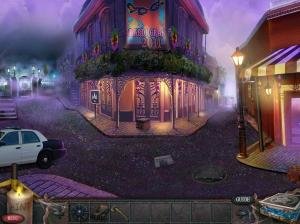 If you are scared of snakes in any way, this probably won’t be the game for you. There are a lot of slithering serpents in this game, and many of them move and hiss in a manner that’s certainly real enough if you have a phobia. Beyond that, as the subject matter would suggest, this game is very atmospheric. I felt the threat of being attacked by the cult around almost every corner, though there’s no need for concern about actually dying. The graphical style establishes much of this mood, as the nicely detailed world is strewn with voodoo imagery, deathly markers, and ominous mystical phenomena throughout the French Quarter, ritualistic graveyards and the eerie bayou and its danger-filled waters. Apart from the snakes, the animation is disappointing, as characters rarely move and other animation largely consists of cut-outs moving across the screen. However, the music and sound effects really hammer the creepiness home. There is a good variety of musical tracks – all of which are slightly unnerving – and many sounds will put you on the edge of your seat, whether it’s the infernal hissing, chanting of cult members or simply creaking doors. A lack of voices is a shame, but their omission isn’t a big deal, as most of your time is spent alone.
If you are scared of snakes in any way, this probably won’t be the game for you. There are a lot of slithering serpents in this game, and many of them move and hiss in a manner that’s certainly real enough if you have a phobia. Beyond that, as the subject matter would suggest, this game is very atmospheric. I felt the threat of being attacked by the cult around almost every corner, though there’s no need for concern about actually dying. The graphical style establishes much of this mood, as the nicely detailed world is strewn with voodoo imagery, deathly markers, and ominous mystical phenomena throughout the French Quarter, ritualistic graveyards and the eerie bayou and its danger-filled waters. Apart from the snakes, the animation is disappointing, as characters rarely move and other animation largely consists of cut-outs moving across the screen. However, the music and sound effects really hammer the creepiness home. There is a good variety of musical tracks – all of which are slightly unnerving – and many sounds will put you on the edge of your seat, whether it’s the infernal hissing, chanting of cult members or simply creaking doors. A lack of voices is a shame, but their omission isn’t a big deal, as most of your time is spent alone.
Item hunts are the prime order of the day, with most of the useful inventory obtained through these searches. The artwork for the hidden object screens is very detailed and packed with objects, making some of the listed objects rather challenging to find. There are no difficulty options available, but the hint system does recharge relatively quickly. Recycling of HOG scenes is an unfortunate shortcoming of the game, with backtracking between previously-visited locations occurring frequently. The fact that shortcuts and new passages across the map open up later in the game does speed things up a little, however, and the backtracking doesn’t feel as arduous in this title as in other similar games. You’ll collect some items directly from the environment as you travel, but there are very few actual inventory-based puzzles. Many of the objects you collect combine automatically when you gather all of the required pieces, making this a fairly streamlined scavenger hunt overall.
 There are a good selection of logic puzzles strewn throughout, from sliding blocks, numbered triangles, light-reflecting mirrors and sheet-music organ tunes. These are all perfectly logical and can often be completed through trial and error alone, though the charging skip system allows for easy progress past any frustrations. The general hint system between puzzles is rather vague, unfortunately, merely providing a general text hint about your current objective that you probably already know. The PCI briefcase acts not only as your journal but also an analysis tool. By dropping certain items of evidence onto it, you can scan fingerprints to find a match or separate elements of a chemical composition. Several magical concoctions are also created here, requiring you to complete a Bejeweled-style minigame or simple matching exercise in order to successfully progress.
There are a good selection of logic puzzles strewn throughout, from sliding blocks, numbered triangles, light-reflecting mirrors and sheet-music organ tunes. These are all perfectly logical and can often be completed through trial and error alone, though the charging skip system allows for easy progress past any frustrations. The general hint system between puzzles is rather vague, unfortunately, merely providing a general text hint about your current objective that you probably already know. The PCI briefcase acts not only as your journal but also an analysis tool. By dropping certain items of evidence onto it, you can scan fingerprints to find a match or separate elements of a chemical composition. Several magical concoctions are also created here, requiring you to complete a Bejeweled-style minigame or simple matching exercise in order to successfully progress.
The bonus Collector’s Edition chapter adds a couple of new locations to explore, but most of it consists of re-used screens. The puzzles are new and different than those in the main game, and come fairly frequently, but they are all clearly signposted and you will probably not get more than an hour of play out of the extra section. Several additional HOG scenes are also introduced, including a new area that wasn’t open before, but this is re-used over and over in the bonus chapter alone. The ending reveals a few surprises and wraps up the slight cliffhanger left at the end of the main story, but it all seems rather contrived. Really the main game provides a satisfactory ending on its own, already providing you with three or four hours of play time, serving as an ample distraction dripping with eerie atmosphere. Horror and supernatural hidden object adventures seem all the rage at the moment, but the tension and fear generated in this title do make it stand out above most others, so despite a few presentational weaknesses, Paranormal Crime Investigations may very well become a “cult” favourite.
Timeless: The Forgotten Town
by Merlina McGovern
Have you ever wanted to put time in a bottle and save a precious moment forever? While saving memories from a wonderful vacation may be fantastic, getting stuck in a town frozen in time from 100 years ago might be kind of a bummer. Fortunately, though you won’t find anything new (either literally or figuratively) as you search through typical hidden object scenes in Boolat Games’ Timeless: The Forgotten Town, you will encounter a wide variety of nicely designed puzzles and an atmospheric magical theme to help pass the time in a place where all the clocks have stopped.
 While aboard a European bullet train on your way to a vacation in Italy, a mysterious figure (aren’t they always mysterious figures?) emerges and menacingly talks about a strange device called a chronometron. Upon the figure’s disappearance, you find yourself seeing visions of old-fashioned train cars and ghostly figures beckoning you to explore. You’ll oblige with a fair amount of roaming the train, but when you finally disembark, you’ll find yourself stepping off a steam engine train rather than the modern one you entered. The surroundings become stranger still as you discover a town completely devoid of people, which has apparently not changed at all since 1907. As you investigate further, you’ll discover a sordid tale involving a count, the love of his life, the time-altering chronometron, and a shady advisor who appears to have dabbled in the dark arts.
While aboard a European bullet train on your way to a vacation in Italy, a mysterious figure (aren’t they always mysterious figures?) emerges and menacingly talks about a strange device called a chronometron. Upon the figure’s disappearance, you find yourself seeing visions of old-fashioned train cars and ghostly figures beckoning you to explore. You’ll oblige with a fair amount of roaming the train, but when you finally disembark, you’ll find yourself stepping off a steam engine train rather than the modern one you entered. The surroundings become stranger still as you discover a town completely devoid of people, which has apparently not changed at all since 1907. As you investigate further, you’ll discover a sordid tale involving a count, the love of his life, the time-altering chronometron, and a shady advisor who appears to have dabbled in the dark arts.
As the townsfolk all appear to have vanished, you’ll need to work your way through a variety of puzzle locks to progress. In addition to typical inventory locks, you’ll also have to use other items to advance through the game, such as finding ways to cross obstacles or reach doors or other objects high off the ground. Some of these items you’ll find by searching through standard hidden object scenes. The designers did mix things up a bit by including silhouetted displays instead of text lists on occasion. These searches are more challenging, as the objects may be much smaller or larger than the silhouettes in your item list. The art is extremely detailed in all search scenes, however, and at times dimly lit, so even the regular hidden object scenes can be challenging if you’re determined not to use a hint.
Balancing out the inventory obstacles and hidden object scenes are a wide variety of logic puzzles. These puzzles are nicely designed, with just the right amount of difficulty. Many times you’ll have to find clues in the environment around you, and your journal keeps track of all of such details. The puzzles move beyond the usual tile and slider variety, although those do make an appearance as well. One clever puppet puzzle requires you to not only decipher what role each puppet represents, but also in which order they should appear on stage. Other puzzles depend on riddle-type clues, such as determining what animal would eat or be eaten by another. You’ll also have to develop photographs, which seems to be de rigueur in casual adventure games nowadays. The themes typically revolve around astrology and dark magic, and stay fairly consistent throughout, with some puzzles involving remembering astrological signs or matching astronomical symbols with their planetary counterparts.

The town is handsomely depicted, though not very memorable, except when it’s beset by a mystical storm that covers it in sand. The town is filled with haunting signs that its inhabitants disappeared quickly: a hotel lobby is strewn with luggage brought in but never opened, and a central square features an elaborate wedding carriage in front of a camera stand, paused forever on the edge of a captured memory. A good amount of ambient animation adds both depth and challenge to the main environments and hidden object scenes alike. Grass waves at the foot of an imposing bronze statue, and light streaming into a tool shed will flicker as if clouds were passing over the sun, sometimes obscuring objects that you need to find. The game makes nice use of background sound as you hear the clickety-clack of train wheels or the tinkle of rolling broken glass when the train comes to a screeching halt. The music is epic at times with soaring melodies, but turns dark and creepy in certain parts, adding to the atmosphere as you begin to uncover the town’s secrets. In a spooky clock repair shop where all of the clocks have stopped, the chittering sound of violins is sure to creep up your spine.
The tangled love story in Timeless: The Forgotten Town makes for an intriguing detour from your intended destination (which you strangely never reach), though it doesn’t quite wrap up completely in the nearly three-hour main game. The hour-long bonus play in the Collector’s Edition has you still trapped in the frozen town, but now set in the count’s mansion, which he and his love still haunt as ghosts. There isn’t too much to do and explore in the bonus section, unfortunately. You’ll investigate a few rooms in the castle, as well as the front courtyard and an inner garden. This extra storyline is a rather silly one involving getting one ghost to talk to the other, clearing up a miscommunication that has lasted for more than a hundred years. It’s not a particularly compelling addition, but the main game has plenty of exploration and engaging puzzles in its own right. You’ll certainly feel like you’ve been here and done all this before, but it’s entertaining enough that this is one town you won’t mind being stuck in for a while.
Unsolved Mystery Club: Ancient Astronauts
by Jack Allin
After exploring the unsolved disappearance of pilot Amelia Earhart the first time around, Freeze Tag set their sights even higher for the sequel – quite literally, as they looked to outer space as the inspiration for Unsolved Mystery Club: Ancient Astronauts. The same can be said figuratively as well, as this “fictional dramatization” tells five stories instead of just one, has considerably improved production values, and is designed far more like a fully-integrated lite adventure than its largely traditional hidden object predecessor. Unfortunately, the increased ambition has led to overshooting the mark on numerous occasions, resulting in a game that feels far less focused and is somewhat more frustrating because of it.
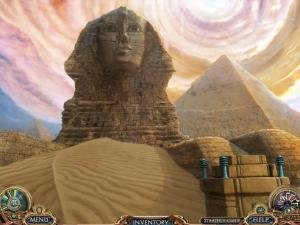 The five different storylines are both a blessing and a curse. On one hand, it allows only a shallow investigation of five intriguing mysteries revolving around the possibility of extra-terrestrial contact with ancient races. Just when you’re getting into the Mayan legend of Pacal the Great or the story behind the geoglyphs in Peru, collecting a few written and video factoids about each along the way, the three-objective limit is fulfilled and you’re whisked back to UMC HQ to begin another. On the other hand, it’s a great excuse to go globe-hopping, and the diversity of locations is easily the game’s greatest strength. One minute you’re at a tribal village in Mali learning about the fish-like Nommo, and the next you’re in the Egyptian desert probing the mystery of the Sphinx, though each story must be completed fully in order. There are quite a few screens per location, all of which are nicely hand-drawn, taking you through crystalline caves, ancient temples, and even to snowy Antarctica. The music is pleasant enough, alternating between a generic adventuring backdrop and suitable ethnic sensibilities. While the playable character never comments on your surroundings, the game is fully voice acted by your guide, Henry Hudson, and a representative of each culture you visit once you’ve found the appropriate means of translation.
The five different storylines are both a blessing and a curse. On one hand, it allows only a shallow investigation of five intriguing mysteries revolving around the possibility of extra-terrestrial contact with ancient races. Just when you’re getting into the Mayan legend of Pacal the Great or the story behind the geoglyphs in Peru, collecting a few written and video factoids about each along the way, the three-objective limit is fulfilled and you’re whisked back to UMC HQ to begin another. On the other hand, it’s a great excuse to go globe-hopping, and the diversity of locations is easily the game’s greatest strength. One minute you’re at a tribal village in Mali learning about the fish-like Nommo, and the next you’re in the Egyptian desert probing the mystery of the Sphinx, though each story must be completed fully in order. There are quite a few screens per location, all of which are nicely hand-drawn, taking you through crystalline caves, ancient temples, and even to snowy Antarctica. The music is pleasant enough, alternating between a generic adventuring backdrop and suitable ethnic sensibilities. While the playable character never comments on your surroundings, the game is fully voice acted by your guide, Henry Hudson, and a representative of each culture you visit once you’ve found the appropriate means of translation.
The bulk of your time will be spent wandering the scenes of each location looking for clues not only to the ancient legends of alien contact, but also the disappearance of five colleagues (a plotline that adds nothing at all to the overall enjoyment). There are some hidden object screens, densely-packed with clutters of area-specific items, but these are few and far between. You’ll spend far more time gathering items to assemble makeshift ziplines and flaming arrows, paint murals, construct juice-powered batteries, and power up generators. This is often far more difficult than in most casual games, as the objective isn’t always clear. Since many puzzles deal with totems and idols and mystical beliefs, it’s hard to predict what solutions are required or what impact they’ll have. Nor can you just follow the trail of interactive sparkles, as no items are highlighted, even on the easier difficulty setting. There is a hint system, but it offers only a sequence of layered text clues, each requiring an inordinately long recharge time. Since you’re unlikely to get stuck on the first step in a sequence, by the time you do need help, you may need to sit through several useless clue-recharge delays just to catch up to where you are. It’s a tedious, extremely un-user-friendly design, making the Collector’s Edition strategy guide more beneficial here than it often is.
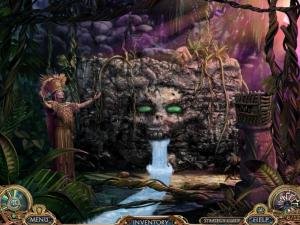
There are plenty of puzzles to solve, many of which are common types like Lights Out, various ring rotators, and several kinds of jigsaw. Most of these are solve-because-they’re-there puzzles, though a few are more clever and culturally relevant, like positioning tribal figures correctly or aligning coloured star patterns. It’s a fairly nice mix for the most part, until the game inexplicably falls into a terrible rut of repetition. Late in the game you’ll need to solve three very difficult sliders in a row, a pair of long trial-and-error sequences that will require notepaper before you’re done, and a couple Simon minigames that feel laughably forced. This repetition extends to the Collector’s Edition bonus chapter, which adds less than an hour to the three hours spent on the main adventure, much of that on increasingly difficult tile-swapping Concentration challenges and a higher rate of hidden object searches. This chapter extends the investigation to the Incan ruins in Bolivia, though it adds nothing to the larger story arc established in the main game.
Perhaps the biggest disappointment comes from the resolution of the legends you’re investigating. The first Unsolved Mystery Club posed several different theories and let the player choose which they preferred. Here there is no such ambiguity, as the game blatantly spells out the “truth” for you. I won’t spoil anything by revealing the ending, but suffice to say that some mysteries are more fascinating because there’s no definitive answer, and it’s a shame the designers felt compelled to wrap it all up in such a conveniently contrived way. It’s not enough to detract from your enjoyment, but it does cheapen the significance of the myths the game explores. If you can live with that and some harder-than-necessary gameplay to that point, there is enough to like about this globetrotting lite adventure to merit a look. Just don’t set your expectations too high, or Ancient Astronauts will bring them tumbling back down to earth.
Vampire Saga: Welcome to Hell Lock
by Jack Allin
Despite being referred to as a Vampire Saga, GO!Games’ Welcome to Hell Lock has nothing whatsoever to do with 2009’s Pandora’s Box. It also doesn’t have much to do with vampires, at least until the end of this hidden object adventure filled more with spectral visions and other mystical phenomena than bloodsucking creatures of the night. It does take place in Hell Lock, at least, as the once peaceful small town of Hill Lock has ominously been dubbed by the now-dead or missing locals. With no introduction beyond a sepia-toned, comic-styled cutscene of a young man crashing his motorcycle, you’re unceremoniously dropped at the town gate with no memory of who you are and no obvious means of escape, as the passage out is blocked by a cave-in of ever-burning underground mines. To make sense of what’s happening and (hopefully) get out, you’ll need to head into town, completing repetitive item hunts and solving a host of inventory puzzles as you go.
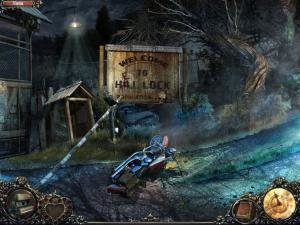 While the first game favoured traditional hidden object hunts over lite adventuring, here the focus seems the reverse – at first. There are many screens to explore in, around, and even under Hell Lock. You’ll investigate a residential house, the fire station, and local theater, among others, before finally descending to the still-smouldering mining caves beneath the streets. There is really only one standalone logic puzzle to solve, in the form of a rotating Venn diagram near the end. You’ll also complete a simple paint-by-numbers task, operate a magnetic crane, and crack a few combination locks with easily-identified clues, but for the most part all puzzles involve simple inventory application. Some items are picked up from the main environment, twinkling rather blatantly so you can’t fail to notice them. Others can only be acquired by scouring through screens for lists of random items.
While the first game favoured traditional hidden object hunts over lite adventuring, here the focus seems the reverse – at first. There are many screens to explore in, around, and even under Hell Lock. You’ll investigate a residential house, the fire station, and local theater, among others, before finally descending to the still-smouldering mining caves beneath the streets. There is really only one standalone logic puzzle to solve, in the form of a rotating Venn diagram near the end. You’ll also complete a simple paint-by-numbers task, operate a magnetic crane, and crack a few combination locks with easily-identified clues, but for the most part all puzzles involve simple inventory application. Some items are picked up from the main environment, twinkling rather blatantly so you can’t fail to notice them. Others can only be acquired by scouring through screens for lists of random items.
For the first half of the game, there are very few object searches to contend with, but about halfway through its nearly-three hour duration, the developers obviously ran out of ideas and decided to simply recycle old ones to double the play time. Both HOG scenes and individual items begin repeating annoyingly, although not consistently. I’m sure there were some screens I never revisited, yet a couple I visited almost four or five times in total. (Perhaps the repeats are randomly chosen, though I wasn’t inspired enough to start over to find out.) The screens are often quite cluttered, making it difficult to find every item, but the game adds an unusual help feature, as any item on the list close to where your cursor is pointed is highlighted in green. This is very useful for finding those last few stubborn items (though the usual recharging hint option exists as well), but the downside is how often you’ll inadvertently be tipped off about items you aren’t even looking for yet. With no way to shut the feature off, this may end up feeling more like a hindrance to your enjoyment than a help.

As the HOG searches come more often, they’re also activated more randomly across town. There’s nothing to alert you to the fact, though the game does include a welcome “map” that shows thumbnails of all locations. Not only can you quick travel to any destination from there, it highlights any screens with currently active puzzles and item searches. Unfortunately, there’s too much reliance on this feature, so expect to begin referencing it constantly in lieu of any intuitive progression of tasks. That’s too bad, because the adventuring premise is a solid framework in its own right, whether you’re repairing equipment, restoring power, eliminating a bug infestation, or even making holy water. The scenery looks good too, hand-drawn in a realistic style using subdued colours, as all the action takes place at night. There is no voice acting at all, and the music is limited strictly to understated background ambience that’s suitably haunting without ever being particularly scary.
There’s no one alive in Hell Lock except you, though you’ll frequently see flashes of ghosts as you enter new areas and spot one recurring half-man/half-smoke creature apparently stalking your progress. The playable character never comments on this, whether oblivious or unperturbed; nor does he seem at all surprised that his camera can reveal hidden blood-marked rubies when the icon flashes on-screen. Indeed, this game does very little to flesh out its storyline, seemingly content to throw arbitrary spooky events at you with no explanation of any kind (ever). That’s not entirely unusual for a casual game, but when the tale does suddenly lurch forward at the game’s climax, it’s completely disconnected from the events that have transpired to that point. Why does your face appear on a “Wanted” poster outside the Sheriff’s office? Why does a skeletal bird transform to a real one and fly off? Why are you collecting “invisible” gems and why can you see ghosts? You won’t get answers to any of these questions, though perhaps they’re still to come, as a teaser clip following the credits hints of more to follow. I’d be happy to see another Vampire Saga, though only if it’s more like the first ninety minutes here than the toothless second half.
Millenium Secrets: Roxanne’s Necklace
by Jack Allin
Diamonds may be a girl’s best friend, but the precious stones in Roxanne’s Necklace may just be the most destructive element on the planet. That’s the premise behind the second installment of Jet Dogs Studios’ Millennium Secrets series. This time around, once-reluctant adventurer Kate McCormick is now an FBI Special Agent, tasked not only with tracking down a rogue agent, but also securing a set of crystals dating back to Alexander the Great. Her investigation takes her to far-flung locations from mountain peaks to ocean floors, though most of what Kate does is solve puzzles and collect objects – lots and LOTS of objects.
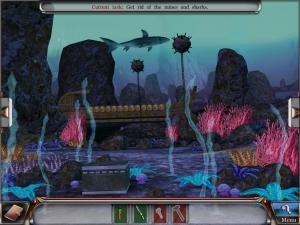 Don’t be fooled by that description, however, as this game is anything but a traditional hidden object adventure. There are about a dozen standard lists of items to find in self-contained screens, but for the most part everything you’re looking for can be found in the main environments you explore. But not quickly, and not easily. At times you’ll simply be looking for individual tools and keys to use as regular inventory, but usually you’ll need to find multiples of the same item, whether it’s machine diodes, wires, chemicals, photos, vase shards, even pointy sea urchins. Sounds simple, but unlike most casual games, here almost all scenes can be rotated in 90-degree increments, significantly expanding the number of screens to scour. Some objects can only be acquired after completing other objectives first, while some are just plain hard to spot in their own right. Finding nondescript herbs in a jungle will likely having you pounding the hint button if you’ve chosen the harder difficulty setting, which doesn’t display intermittent twinkles to alert you to interactive areas. Or you could just access the quick travel map, which helpfully identifies all areas with items available or goals to complete.
Don’t be fooled by that description, however, as this game is anything but a traditional hidden object adventure. There are about a dozen standard lists of items to find in self-contained screens, but for the most part everything you’re looking for can be found in the main environments you explore. But not quickly, and not easily. At times you’ll simply be looking for individual tools and keys to use as regular inventory, but usually you’ll need to find multiples of the same item, whether it’s machine diodes, wires, chemicals, photos, vase shards, even pointy sea urchins. Sounds simple, but unlike most casual games, here almost all scenes can be rotated in 90-degree increments, significantly expanding the number of screens to scour. Some objects can only be acquired after completing other objectives first, while some are just plain hard to spot in their own right. Finding nondescript herbs in a jungle will likely having you pounding the hint button if you’ve chosen the harder difficulty setting, which doesn’t display intermittent twinkles to alert you to interactive areas. Or you could just access the quick travel map, which helpfully identifies all areas with items available or goals to complete.
You’ll also have numerous logic puzzles to solve along the way. There are plenty of standard types here, from assembly puzzles to marble poppers to coded and coloured wire connections, but most do a good job of adding a twist that makes them much more challenging. Gear puzzles include movable belts, tile jigsaws move pieces in attached pairs, and staggered rings must be aligned so that no patterns overlap. Although the puzzles start out fairly easy, they get increasingly difficult as you go. One hexagon slider almost drove me to the puzzle skip option, and a couple finally did, like mixing primary colours to light crystals – a simple enough concept, except the actual goal isn’t clear and there’s no feedback to gauge where you are going wrong or why. On the other end of the difficulty spectrum, whenever a secondary clue is involved, the information is automatically displayed for you on the appropriate puzzle screen. It’s very helpful to not have to memorize a lock sequence even momentarily, but it means you really don’t have to pay much attention. Just click on everything with a hotspot, and you’ll be handed the info you need when the time is right.
All this gameplay adds up, and it could easily take you five or so hours to get through the game. Unfortunately, much of it feels like padding, as it just takes a long time to scrutinize each four-sided screen, then click ahead to the next location and lather, rinse, repeat. The items may change, but the formula never does. This functionality comes with a graphical price, too, as the game is presented in a rather unappealing 3D, with muddy textures and very little artistry. There’s a nice selection of locales all told, from the European Alps to a museum library, a tribal village, and even a submerged shipwreck, but you’ll spend plenty of time in drab buildings as well, and most scenes are sparsely decorated and shown at a distance, making for a very dull visual experience. Character models are decently done, though the lip-syncing is atrocious. You could read the intrusive subtitles instead, but the game is fully voice acted to a fairly high standard, so there’s really no need. The rest of the audio is forgettable, with minimal sound effects and a generic sci-fi sort of background tune playing at times. That suits the vibe of the story, which teases of extra-terrestrial involvement and secret societies, but never does anything with them besides sending you on yet another scavenger hunt, right up to the anti-climactic non-ending. If you’re tired of all the same-old hidden object games, Millennium Secrets: Roxanne’s Necklace will certainly be a change of pace at first, though expect it to wear out its welcome before the end, so don’t expect a gem.
Intrigue Inc: Raven’s Flight
by Jack Allin
It may be tempting to turn up your nose at Skunk Studios’ Intrigue Inc: Raven’s Flight due to its limited production values, but beneath the surface there’s a decent amount of lite adventuring and hidden object hunting to be found. The laughably threadbare story puts you in the shoes of an operative for the titular global protection agency, tasked with chasing down a rogue agent with plans of world domination. All that really means is chasing him from his luxury boat to his beachside villa to penthouse apartment, learning of his maniacal plans through conveniently scattered tell-all memoirs while gathering items and solving inventory puzzles along the way.
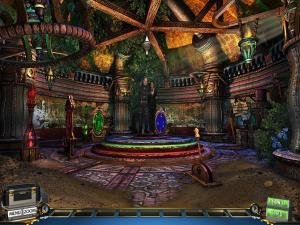 Many objects are found in traditional hidden object screens with several interactive items per scene. A few scenes visibly display the items to collect, but most are traditional lists of items, though you can see silhouettes of these as well by clicking on the words. The searches are rarely if ever repeated until the very end, as the game continually progresses in a streamlined fashion of three or four screens per area. Given the spy theme, many of the puzzles suitably involve avoiding traps like security cameras and electrified gates, while others have you repairing equipment or manually assembling makeshift tools once you’ve found all the parts. On the easier difficulty setting, interactive areas sparkle and outlines of necessary inventory items are shown to hand-hold you through solutions, making the harder difficulty a much better alternative if you want any challenge at all. There are hints and puzzle skips available, but although the recharge time is very slow, you likely won’t need them given the limited options at any given time and the simplicity of the puzzles.
Many objects are found in traditional hidden object screens with several interactive items per scene. A few scenes visibly display the items to collect, but most are traditional lists of items, though you can see silhouettes of these as well by clicking on the words. The searches are rarely if ever repeated until the very end, as the game continually progresses in a streamlined fashion of three or four screens per area. Given the spy theme, many of the puzzles suitably involve avoiding traps like security cameras and electrified gates, while others have you repairing equipment or manually assembling makeshift tools once you’ve found all the parts. On the easier difficulty setting, interactive areas sparkle and outlines of necessary inventory items are shown to hand-hold you through solutions, making the harder difficulty a much better alternative if you want any challenge at all. There are hints and puzzle skips available, but although the recharge time is very slow, you likely won’t need them given the limited options at any given time and the simplicity of the puzzles.
For a little (less believable) variety, a few standalone puzzles like rotating rings and tracing tangled wires are introduced, all of which are extremely easy. Code locks always have blatant clues nearby, and even minigames like magnetized fishing, laser avoidance, and cooking for clues (oh, those dastardly Smell-o-Safes!) are child’s play to complete. Apparently the entry requirements to Intrigue, Inc. aren’t too demanding. The final sequence is a rather obnoxious maze, which isn’t that big or difficult to navigate, but there are multiple items hidden within it, and you’ll have to scope the entire area in full to collect them all. The payoff is a final confrontation with “Raven” after nearly three hours of pursuit, which concludes the story decently, if not exactly climactically. With such a paper-thin plot further weakened by rather blocky, nondescript graphics, an absence of voice acting and only periodic spy-themed music attempting to insert some otherwise-missing drama, this is clearly not a game for story lovers or eye candy connoisseurs. The routine gameplay won’t dazzle you either, but if you have a few free hours to devote to a mission that’s very much possible (if not a little too much so), you may just find enough to make this game intriguing enough to warrant a look.
Foreign Dreams
by Jack Allin
There are two nightmare realms to explore this month, although Kohey’s Foreign Dreams represents by far the kinder, gentler – and sadly, lesser – world of nighttime imagination available this month. A young man named Victor is experiencing terrible dreams, and his psychically-gifted friend Maya is the only one who can help by inserting herself into his nightmares and seeking the source of the disturbance. As Maya, you’ll delve ever deeper into a subconsciously repressed mystery that dates all the way back to Victor’s childhood, following an eerily silent little girl through a variety of surreal environments in search of clues, puzzles, and a host of hidden items.
 With no introduction at all, this premise is established strictly through a mute conversation between Maya and Victor as play begins, which is a sign of the budget shortcuts you can expect throughout the game. Much of what’s here is solid enough; there just isn’t a whole lot of it. Locations are reasonably diverse, but many are surprisingly mundane: rooftops and street alleys, train and bus stations, a bar, playground, hospital room, and countryside are all fine but do little to capitalize on the creative possibilities of dreams. A photo-strewn “hall of memories” suspended in outer space and an underwater morgue with a mannequin corpse and circling anglerfish are welcome exceptions. Fortunately, it’s all presented in an attractive art style, with realistic backgrounds drawn in bold outlines like a graphic novel. The 3D characters jar a bit in contrast, but they appear only occasionally. A pleasant but short musical track accompanies the early part of your adventure before giving way to silence, then abruptly starts all over again and begins an endless looping cycle that repeats until the end.
With no introduction at all, this premise is established strictly through a mute conversation between Maya and Victor as play begins, which is a sign of the budget shortcuts you can expect throughout the game. Much of what’s here is solid enough; there just isn’t a whole lot of it. Locations are reasonably diverse, but many are surprisingly mundane: rooftops and street alleys, train and bus stations, a bar, playground, hospital room, and countryside are all fine but do little to capitalize on the creative possibilities of dreams. A photo-strewn “hall of memories” suspended in outer space and an underwater morgue with a mannequin corpse and circling anglerfish are welcome exceptions. Fortunately, it’s all presented in an attractive art style, with realistic backgrounds drawn in bold outlines like a graphic novel. The 3D characters jar a bit in contrast, but they appear only occasionally. A pleasant but short musical track accompanies the early part of your adventure before giving way to silence, then abruptly starts all over again and begins an endless looping cycle that repeats until the end.
Gameplay is similarly formulaic. You’ll enter five dreams in total, each consisting of three distinct screens (plus close-ups) with three objectives to accomplish. As each new task is identified, whether fixing a jukebox, repairing rock band equipment or developing photos, a group of related item images is displayed at the bottom of the screen. All items are found in the main environments, some of which are small and difficult to find without accessing a hint. Most objects are relevant, though this being a dream, some defy logic, like finding missing letters for a book. Only a few items are actually used as inventory, as most serve their purpose automatically once all the parts are found. In each dream, you’ll need to find an increasing number of items to construct a dreamcatcher to exit, which gets old quickly since you can’t pick the objects up until it’s time to leave. There are some familiar standalone puzzles, from jigsaws to rotators to colour-matching sequences, but most of them are incredibly easy, so choose the harder difficulty setting if you want even a modicum of challenge. Even if you do, you’ll likely breeze through, and just when you begin to uncover a surprisingly intriguing backstory, it’s all wrapped weakly up in an anti-climactic rush. It’s a shame that so many corners were cut, because there was potential for so much more. As it is, there’s some decent hidden object adventuring to be found here, but if you expect to get any more than two hours at most out of this game, pinch yourself because you’re dreaming.
Note: Developer’s name may be incorrect, as no company was listed in the credits, and the name appeared only once in barely-legible font at game’s end.
Lara Gates: The Lost Talisman
by Jack Allin
The latest heroine to draw her own top billing in a hidden object adventure is Lara (don’t-call-me-Croft) Gates in Cattale Games’ The Lost Talisman. Unfortunately, it’s a rather inauspicious debut for the young antiquities expert, as instead of tracking down artifacts on a worldwide adventure, here she never really gets out of school – literally. While appraising seven unique talismans for the Dean of Banderville College, Lara discovers that separating them will result in a great evil being unleashed. Whoops! Wouldn’t you know it, the talismans are indeed scattered around the college. That can’t be good. Now the Dean is missing, an ominous storm cloud swirls over the building, and it’s up to Lara to find the artifacts and a whole lot of other hidden items in time.
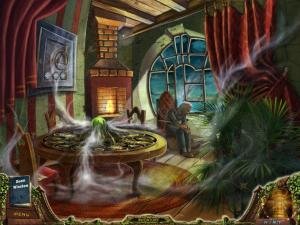 Probably best suited for beginners on either difficulty setting, this game is a highly streamlined adventure through the school’s various hallways and classrooms, whether biology, music, or geography, with stops in the library, courtyard, and basement along the way. You can “freely” explore the grounds, but you can’t enter any doorway that isn’t currently relevant, and any room newly activated will be conveniently propped open to point the way. You’ll find scattered clue pages lying around, but the puzzles are so simplistic that you may never refer to them in your journal. You’ll rotate rings, match tangled wires, and connect chemistry pipes, but often the puzzle design goes out of its way to help you out. The familiar gear puzzle is colour-coded here to prevent any possibility of failure, while pinning a butterfly collection by colour is trivialized by rejecting incorrect choices and locking correct ones in place, making trial-and-error an easier (albeit lazier) option. You’ll also need to arrange books in order, but its solution is better suited to Sesame Street than a casual game for adults.
Probably best suited for beginners on either difficulty setting, this game is a highly streamlined adventure through the school’s various hallways and classrooms, whether biology, music, or geography, with stops in the library, courtyard, and basement along the way. You can “freely” explore the grounds, but you can’t enter any doorway that isn’t currently relevant, and any room newly activated will be conveniently propped open to point the way. You’ll find scattered clue pages lying around, but the puzzles are so simplistic that you may never refer to them in your journal. You’ll rotate rings, match tangled wires, and connect chemistry pipes, but often the puzzle design goes out of its way to help you out. The familiar gear puzzle is colour-coded here to prevent any possibility of failure, while pinning a butterfly collection by colour is trivialized by rejecting incorrect choices and locking correct ones in place, making trial-and-error an easier (albeit lazier) option. You’ll also need to arrange books in order, but its solution is better suited to Sesame Street than a casual game for adults.
There are a few equally basic inventory puzzles, though most of the items you’ll acquire come directly from hidden object searches. Item hunts occur quite frequently, repeat once each and are activated without notice, though backtracking to find the telltale sparkle takes mere seconds. There’s nothing particularly noteworthy about these searches for standard lists of random junk. Fortunately, while the visual impact is minimized by the dull locations, the graphics are nice to look at in their own right, hand-drawn in a slightly cartoony style and skewed as if being viewed through a glass bowl. The still panel cutscenes are also attractive, though they forward the story only through silent text. The music consists largely of light background piano and occasionally eerie chanting, though it never achieves much in the way of atmospheric ambience. In fact, despite the supposed imminent danger, there’s really no urgency or tension of any kind. When you do reach the end of your quest less than two hours after you began, there’s little sense of accomplishment or even closure, as the game simply teases of a greater adventure to come. I’ll stop short of saying Lara Gates: The Lost Talisman is as much fun as actually being in school, but this new series introduction is so blatantly mediocre and unambitious, the question remains: why didn’t they just start with the sequel?
Note: Adventure Gamers is a Big Fish Games affiliate.

























